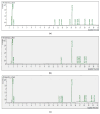Analysis of Chlorpyrifos Pesticide Residue in Locally Grown Cauliflower, Cabbage, and Eggplant Using Gas Chromatography-Mass Spectrometry (GC-MS) Technique: A Bangladesh Perspective
- PMID: 38891008
- PMCID: PMC11171951
- DOI: 10.3390/foods13111780
Analysis of Chlorpyrifos Pesticide Residue in Locally Grown Cauliflower, Cabbage, and Eggplant Using Gas Chromatography-Mass Spectrometry (GC-MS) Technique: A Bangladesh Perspective
Abstract
Pesticides are chemical substances used to kill or control various types of pests, which are hazardous for crops and animals. Pesticides may remain on or in foods after these are applied to crops. Pesticide residue in food has been a major global concern since there are direct and indirect health hazards associated with the regular consumption of foods with pesticide residues. Chlorpyrifos is one of the most used pesticides that has received much attention worldwide due to its detrimental health impact. The presence of chlorpyrifos residue in food crops can have both long-term and short-term effects on consumer health. Bangladesh is an agricultural country that uses a high volume of pesticides every year including chlorpyrifos. This experimental study aimed to analyze chlorpyrifos pesticide residue in locally grown cauliflower, cabbage, and eggplant samples by gas chromatography-mass spectrometry (GC-MS) technique followed by a suitable extraction process. Commercially available cauliflower, cabbage, and eggplant samples along with samples cultivated with the recommended pesticide dose were collected for qualitative and quantitative analysis. Samples cultivated without chlorpyrifos were collected as control samples for the validation study. The method was validated with respect to accuracy, recovery, reproducibility, linearity, limit of detection, and limit of quantification. The method has a limit of detection (LOD) of 0.011 mg/kg and a limit of quantification (LOQ) of 0.034 mg/kg. The experimental results were compared to the maximum residue level (MRL) to assess the human health impact. Chlorpyrifos residue was found in 44% of cauliflower samples with 91% of samples higher than MRL. The residue was found in 68% of cabbage samples with 53% of samples higher than MRL. For eggplant, the residue was found in 80% of the samples with 65% of samples higher than MRL. The risk assessment based on the residue level found in this study shows a potential health hazard of having a high concentration of chlorpyrifos residue in locally grown vegetables.
Keywords: chlorpyrifos; extraction; gas chromatography–mass spectrometry; health hazard; maximum residue level; pesticide; validation.
Conflict of interest statement
The authors declare that they have no conflicts of interest.
Figures





Similar articles
-
Pesticides in vegetable production in Bangladesh: A systemic review of contamination levels and associated health risks in the last decade.Toxicol Rep. 2023 Sep 9;11:199-211. doi: 10.1016/j.toxrep.2023.09.003. eCollection 2023 Dec. Toxicol Rep. 2023. PMID: 37711360 Free PMC article. Review.
-
Surveillance and dietary risk assessment of endocrine-disrupting pesticides in eggplant/brinjal and cauliflower in Pakistan.Environ Sci Pollut Res Int. 2023 Mar;30(12):33650-33659. doi: 10.1007/s11356-022-24624-y. Epub 2022 Dec 9. Environ Sci Pollut Res Int. 2023. PMID: 36481860
-
[High-throughput screening of multi-pesticide residues in animal-derived foods by QuEChERS-online gel permeation chromatography-gas chromatography-tandem mass spectrometry].Se Pu. 2023 Jul;41(7):610-621. doi: 10.3724/SP.J.1123.2022.10010. Se Pu. 2023. PMID: 37387282 Free PMC article. Chinese.
-
Quantitative determination and removal of pesticide residues in fresh vegetables and fruit products by LC-MS/MS and GC-MS/MS.Environ Monit Assess. 2023 Jan 7;195(2):277. doi: 10.1007/s10661-022-10910-2. Environ Monit Assess. 2023. PMID: 36609771
-
[Screening and confirmation of 244 pesticide residues in chilli by gas chromatography-quadrupole time-of-flight mass spectrometry].Se Pu. 2021 May;39(5):494-509. doi: 10.3724/SP.J.1123.2020.11019. Se Pu. 2021. PMID: 34227334 Free PMC article. Chinese.
Cited by
-
Understanding the factors behind non-adherence to pesticide safety guidelines among smallholder farmers in Fogera and MEcha districts, northwestern Ethiopia.BMC Res Notes. 2025 Apr 16;18(1):177. doi: 10.1186/s13104-025-07217-z. BMC Res Notes. 2025. PMID: 40241208 Free PMC article.
References
-
- Hossain L., Rahman R., Khan M.S. Pesticide Residue in Foods. Springer; Berlin/Heidelberg, Germany: 2017. Alternatives of pesticides; pp. 147–165.
-
- Khan M.S., Rahman M.S. Pesticide Residue in Foods. Springer; Berlin/Heidelberg, Germany: 2017.
-
- Rehman S., Shahzad M.S.M. A Quantitative Analysis for the Toxic Pesticide Residues in Marketed Fruits and Vegetables in Lahore, Pakistan. Biomedica. 2017;25:2
-
- Dasgupta S., Meisner C. Health Effects and Pesticide Perception as Determinants of Pesticide Use: Evidence from Bangladesh. World Bank Publications; Dhaka, Bangladesh: 2005.
-
- Bianchi M., Chopin F., Farme T., Franz N., Fuentevilla C., Garibaldi L., Laurenti A. FAO: The State of World Fisheries and Aquaculture. Food and Agriculture Organization of the United Nations; Rome, Italy: 2014. pp. 1–230.
Grants and funding
LinkOut - more resources
Full Text Sources
Miscellaneous

